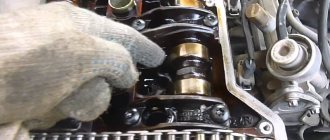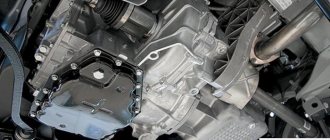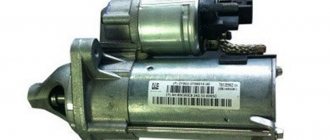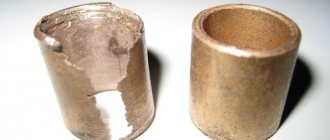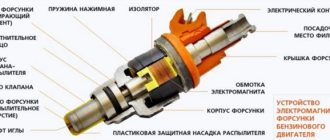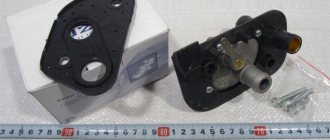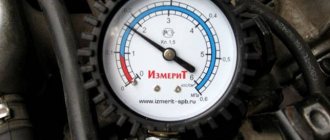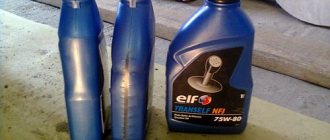Date of publication. Published in Renault Secrets
Renault has been producing a wide variety of gearboxes for many years, from classic “mechanics” to advanced “robots” and CVTs. Today we will look at popular manual transmission models.
Owners will find the transmission number on the identification plate at the bottom of the crankcase. An easier option is to check the box model using the car's VIN code.
Boxes Lada Largus
- Auto
- Lada
- Largus
- checkpoint
During its production, three different gearboxes were installed on the Lada Largus:
| 5-speed Renault JH3 | classic mechanics with lever control drive |
| 5-speed Renault JR5 | classic mechanics with cable drive control |
| 5-speed manual transmission VAZ 21809 | AvtoVAZ transmission replaced foreign manual transmission |
Price of five-speed manual transmission Renault JH3
| Minimum cost | 15,000 rubles |
| Average price on the secondary market | 30,000 rubles |
| Maximum cost | 45,000 rubles |
| Contract gearbox abroad | 300 euros |
| Buy such a new unit | 76,000 rubles |
Renault JH3 gearbox
40 000
rubles
| State: | contractual |
| Factory number: | 7702302090 |
| For engines: | K7M |
| For models: | Renault Logan 1, Megane 1 and others |
* The price for this gearbox is for reference only
Failure of bearings on the JH-3 manual transmission
Renault JH3 - manual transmission Lada Largus 1.6 8v
Five-seater Largus modifications with an 8-valve K7M engine were equipped with a JH3 gearbox. This is the simplest five-speed manual transmission in the Renault range. Here, the control lever drive and synchronizers are only on forward gears, and the manual transmission clutch is driven by a regular cable, without any hydraulic drive.
The box is reliable and worries only about small things, such as play in the lever or leakage from under the rod. But the manual transmission also has one weak point: the role of the left drive oil seal here is played by the boot of the internal tripod, which tends to wear out quite quickly and leak. And if you don’t notice the leak in time, then you can somehow leave the box completely without oil.
Gear ratios of the JH3 540 manual transmission (5-seater station wagon with K7M engine):
| home | 1st | 2nd | 3rd | 4th | 5th | Rear |
| 4.214 | 3.727 | 2.048 | 1.393 | 1.029 | 0.820 | 3.545 |
The online manual for Largus boxes is here
Manual transmission TL8, art.
This transmission was developed on the basis of the TL4 and was intended for 4X4 Renault-Nissan models.
A hydraulic clutch drive, two flexible control cables, a twin-shaft system and synchronizers in all gears, including reverse - this is the design of the TL8. The driveshaft is connected through a gearbox and transmits torque to the rear axle. All-wheel drive is activated from inside the cabin when the switch closes the electromagnetic clutch.
The TL8 is equipped with engines developing up to 240 Nm of torque. Among the features is a short first gear, which owners often use as a reduction gear when off-road.
The resource of TL8 is about 150 thousand, and this, of course, is not much. But if you change the oil every 60 thousand and do not participate in off-road racing, you can actually extend the life of the unit by 2-3 times.
As for characteristic malfunctions, the TL8 sometimes howls spontaneously, according to complaints from owners. There are also oil leaks through seals and gaskets. There have been cases of transmission destruction at ridiculous mileage, but, as a rule, they are associated with gross errors during assembly at the factory, such as underfilling the unit with oil.
Do not miss:
- The three most reliable Renault engines, read here
- 3 of the worst Renault engines, read here.
Renault JR5 - manual Lada Largus 1.6 16v
The seven-seat modifications of the station wagon and versions with 16-valve internal combustion engines were equipped with the JR5 gearbox. This is a more advanced mechanics designed for high torque engines. There is already a cable drive for controlling the transmission, and there is also a hydraulic clutch.
In terms of reliability, it has no special problems and with regular replacement of lubricant, the gearbox lasts a long time. However, if you drive on old oil for a long time, the shaft bearings will hum, and then completely fall apart, and their rollers will get into the differential and the transmission will jam. Also on the specialized forum there are complaints about lubricant leaks and freezing of control cables.
Gear ratios of manual transmission JR5 551 (7-seater station wagon with K7M engine)
| home | 1st | 2nd | 3rd | 4th | 5th | Rear |
| 4.500 | 3.727 | 2.048 | 1.321 | 0.971 | 0.795 | 3.545 |
Gear ratios of manual transmission JR5 549 (station wagon 5 and 7 seats with K4M engine)
| home | 1st | 2nd | 3rd | 4th | 5th | Rear |
| 4.214 | 3.727 | 2.048 | 1.393 | 1.029 | 0.892 | 3.545 |
Gear ratios of manual transmission JR5 517 (van with all power units)
| home | 1st | 2nd | 3rd | 4th | 5th | Rear |
| 4.928 | 3.727 | 2.048 | 1.321 | 0.971 | 0.738 | 3.545 |
5 manual transmission (JR5)
Available configurations and prices
If a five-speed manual transmission is enough for comfortable driving around the city or on the highway, then you can safely choose the option with a manual transmission5. This unit is identified by the code JR5 according to the Renault company classification. This transmission is equipped with cars in the “Life” (basic configuration) and “Drive” modifications with front-wheel drive and a 1.6-liter engine. The cost is 1,015,000 rubles. and 1105990 rub. respectively.
Specifications
JR5 has been designed by the company's engineers for a long time and has been successfully used on other Renault, Lada and Nissan models for many years. Therefore, it was decided to use it on the new representative of the model range.
Gear ratios
One of the main characteristics of the transmission is rightfully the gear ratio in each gear. Below are the data for 5 manual transmission.
- 3,727.
- 2,048.
- 1,321.
- 0,971.
- 0,738.
For reverse the number is 3.545.
Design
This gearbox was not created from scratch. The basis was taken from an old design marked JH3 and reworked to suit modern needs. The basis remains the same: a two-shaft arrangement using synchronizers in all stages and combining with the main gear and differential into one system.
Among the improvements made by engineers, experts note:
- Installation of a hydraulic clutch, which replaced the use of a cable. By such actions, a softer moment of changing gear stages was achieved.
- Direct activation is now carried out by two flexible cables, and not by a rigid rod, as before. This made it possible to remove vibrations inside the unit.
- The Renault Arcana manual transmission in 5 gears can withstand 200 Nm, while its predecessor only 160. The difference of almost 25% is quite noticeable.
- Most of the box is made of aluminum and steel alloys.
- High-quality sealants are used to seal the product.
- The teeth of the reverse gears are different - they are straight, not oblique, as for all the other five.
- Different types of secondary shaft bearings are used, namely ball and roller.
The working cylinder and bearing are combined into one unit and bolted to the crankcase.
Exploitation
Resource
According to Renault company representatives, the service life of the JR5 gearbox without repairs or breakdowns can be 250 thousand kilometers. After this, if not earlier, of course, adventures will begin in the form of repairs or replacement of individual components. To prevent this from happening, you need to keep an eye on the box. The first thing is to change the oil on time, do not overload in cold or very hot seasons, and do not transport cargo more than allowed in the technical specifications. In practice, with a gentle operating mode without major repairs, it turns out to “run back” twice as much
Change of oil
According to the scheduled list of replacement works, a mask is not provided for in the Renault Arcana manual transmission. But service center specialists insist on changing the fluid every 60 thousand mileage. The procedure will not cost the owner very much, but will significantly extend the life of the unit. To change, you need to use branded oil ELF Tranself NFJ 75W80. For a complete replacement, 2.5 liters will be enough.
VAZ 21809 - modern manual transmission Lada Largus
In 2022, a station wagon with a 16-valve internal combustion engine VAZ 21129 received a domestic gearbox 21809. This is a modern 5-speed manual transmission with a cable drive control, but without a hydraulic clutch, equipped with reliable multi-cone synchronizers in first and second gears.
Due to the relative novelty of this manual transmission, comprehensive breakdown statistics have not yet been collected. On the forums you can find complaints about transmission noise in a certain speed range, difficult shifts due to premature wear of synchronizers and oil leaks. Owners also note extraneous noises and knocking in the gearbox at idle engine speeds.
Reliability jr5
It’s difficult to praise the mechanical JR5 in any way, but there’s nothing particularly to reproach either. The unit itself is structurally simple, often hums, and the clarity of gear shifting leaves much to be desired. Over time, it requires overhaul or, in severe cases, replacement due to the destruction of key mechanisms. Often, car owners have to disassemble the box because the 5th speed refuses to turn off.
A roller bearing with a plastic cage on the secondary shaft is another weak point of the JR5 mechanics. The separator often falls apart even at short mileage, which leads to balls clumping together. At a minimum, the manual transmission starts to hum, but there have been cases when balls got caught between the gears. The deficiency was eliminated after the JR5 modernization.
Many problems can be avoided if you follow the manual transmission maintenance regulations and use original oil. It is advisable to change the working material of the box every 50-60 thousand kilometers. TranselfTRJ 75W-80 is suitable for replacement. After passing 10-15 thousand km, it is necessary to take control measurements of the fluid. In general, the box is old, moderately reliable, but not perfect. With the right approach it will last a long time and can be repaired without problems.
Gearbox Lada Largus: design and features
Lada Largus is a popular car from the largest passenger car manufacturer in Russia, AvtoVAZ. The car is actually a Russian copy of a French car (a joint project between Renault and AvtoVAZ on the B0 platform).
The manufacturer offers the model in several versions: 5-door station wagon (five-seater), minivan, etc. Largus is equipped with four gasoline engines and manual gearboxes JH3 and JR5. Next, we will look at what features the Largus gearbox has, as well as what a manual transmission is on this car.
What cars are equipped with the Renault JH3 gearbox?
Dacia
| Logan 1 | 2004 — 2012 |
| Sandero 1 | 2008 — 2012 |
Renault
| Clio 2 | 2001 — 2006 |
| Clio 3 | 2005 — 2014 |
| Kangoo 1 | 2002 — 2008 |
| Kangoo 2 | 2008 — 2011 |
| Fluence 1 | 2010 — 2017 |
| Laguna 2 | 2001 — 2005 |
| Logan 1 | 2005 — 2016 |
| Logan 2 | 2014 - present |
| Logan 2 Stepway | 2018 - present |
| Modus 1 | 2004 — 2012 |
| Megane 2 | 2002 — 2009 |
| Megane 3 | 2008 — 2013 |
| Sandero 1 | 2009 — 2014 |
| Sandero 2 | 2014 - present |
| Sandero 1 Stepway | 2010 — 2014 |
| Sandero 2 Stepway | 2014 - present |
| Symbol 1 | 2002 — 2008 |
| Symbol 2 | 2008 — 2013 |
| Scenic 2 | 2003 — 2009 |
| Twingo 2 | 2007 — 2013 |
| Wind 1 | 2010 — 2013 |
Lada
| Vesta sedan 2180 | 2015 — 2016 |
| X-ray hatchback | 2016 — 2017 |
| Largus station wagon | 2012 — 2015 |
| Largus van | 2012 — 2015 |
Gearbox Lada Largus: features
The manual transmission of the Lada Largus car is a five-speed gearbox. The box effectively transmits torque from the internal combustion engine to the driving front wheels, while ensuring clear and smooth engagement of the selected gear in accordance with the speed limit.
As mentioned above, manual transmissions on Largus can be units with the index JH3 and JR5. The JHZ five-speed manual transmission model is installed on Lalgus cars with the K7M engine. Cars of this brand with other power plants are equipped with a JR5 manual transmission.
Structurally, these boxes are similar, however, some elements of the clutch release and gear shift mechanisms, as well as the design for connecting the drive wheel drives, are somewhat different.
Features of the manual transmission version JHZ:
- the unit for turning on and off the gearbox clutch is a clutch with a bearing, moved along a guide sleeve by a fork, which is acted upon by a cable connected to the clutch pedal;
- The gearbox is controlled using a rigid rod;
- The gear ratios between the primary and secondary shafts are different from the gear ratios of the JR5 box (gears: I-3.72 II-2.04 III-1.39 IV-1.02 V-0.79 reverse-3.54 main-4 ,21).
Distinctive features of the manual transmission version JR5:
- the unit for turning on and off the gearbox clutch is a hydraulic working cylinder, combined with the clutch release bearing and through a pipeline connected to the main cylinder, the rod of which is affected by the clutch pedal;
- The gearbox is controlled via two flexible cables;
- the gear ratios between the primary and secondary shafts will differ from the gear ratios of the JHZ box (gears: I-3.73 II-2.05 III-1.32 IV-0.97 V-0.82 reverse-3.55 main-3 ,73).
Manual transmission JR5, 5 speed
The design of this common box is based on the two-shaft JH3. At the same time, the designers proposed a number of improvements and differences for the JR5. Thus, gears are now switched not using a rigid rod, but through two flexible cables, which dampens vibration.
The clutch drive cable has been replaced with a hydraulic drive, which also has a positive effect on the operating culture of the transmission. In addition, the JR5 can handle 200 Nm of torque compared to 160 Nm in the JH3.
Lada Largus: gearbox and device of JH3 and JR5 models
The units are made according to a two-shaft design. Manual transmissions JH3 and JR5 have synchronizers for all forward gears, combined with a differential and final drive with a common housing.
Inside the housing of both manual transmission models, made of aluminum alloy, there is a primary shaft with a set of drive gears and a secondary shaft with driven gears located next to it.
Like many other manual transmissions, the Largus box of the JH3 and JR5 models has a clutch fork, gearbox housing, clutch housing, filler plug, speed sensor, manual transmission control lever, gear shift lever, breather, gear shift mechanism, etc.
Main components of the JH3 manual transmission control drive:
- backstage;
- gear shift lever with a ball joint secured with nuts to the base of the body;
- manual transmission control drive rod;
- mechanism rod installed on the crankcase, etc.
As for the JR5 manual transmission control drive, the following elements can be distinguished:
- backstage;
- two flexible cables;
- gear shift mechanism installed on the gearbox housing;
At the same time, even taking into account some differences, both types of gearboxes on the Lada Largus have proven themselves to be quite reliable and repairable units.
Box diagram
The JH3 gearbox is identical to the JH1 gearbox (Logan 1.4) and the JR5 gearbox, which is installed on the Largus. The only difference lies in the clutch housing. Everything else, including the main gear, is identical.
Visually, the gearbox consists of 3 parts: the clutch housing, the gearbox housing itself, and the rear cover of the gearbox housing. A special feature of the box is that the gearbox is combined with a differential and final drive.
In addition, it is necessary to monitor the oil level in the gearbox; the level should not be below the lower edge of the filler hole, otherwise the gears will starve of oil (How to check the oil level?).
The jh3 gearbox is paired with the 21129 1.6l engine
The jr5 gearbox comes with a 1.8 liter engine. Previously, this box was installed on Largus.
Other transmissions:
What's the result?
The design of the gearbox installed on the entire Lada Largus model range, regardless of modifications (JR5 or JH3, etc.), is quite modern and reliable. As a rule, these manual transmissions rarely fail.
If malfunctions and breakdowns of the manual transmission occur (gears fly out or do not shift, noise or crackling noise occurs, etc.), then comprehensive diagnostics should be carried out to identify malfunctions.
Repairs should also not be delayed, since the design of the box is complex; one malfunction can lead to another. It is recommended to immediately contact a service station, where experienced specialists will be able to quickly and efficiently eliminate existing problems.
Gearbox for Lada Vesta: types of manual transmission Lada Vesta, robotic gearbox Lada Vesta. Changing the oil in the Lada Vesta box.
Checking the oil in the Lada Granta gearbox: how to check the oil level in the Lada Granta automatic transmission, checking the oil in the Granta manual transmission. Adding oil, recommendations.
Automatic transmission on the domestic GAZelle Next car: features of automatic transmission, advantages and disadvantages of automatic transmission.
Automatic transmission for Renault Duster: Renault Duster automatic transmission and Duster with a robotic gearbox. Features of these types of automatic transmissions for Duster.
Russian cars with automatic transmission: automatic transmissions on models from the USSR, modern Russian cars with automatic transmission. Popular models, types and types of automatic transmissions.
Lada Vesta with an automatic transmission: what type of automatic transmission is on the Lada Vesta, pros and cons. Prospects for the appearance of an automatic transmission or a CVT on Vesta.
Renault JH3 gearbox maintenance schedule
The manual transmission oil is considered to be filled for its entire service life, but we recommend changing it every 60,000 km. The box contains 3.2 liters of Elf Tranself NFJ 75W-80, and when replaced, just under 3 liters are included.
Changing the oil in such a manual transmission using the example of Renault Logan
Gearbox jh3 or jr5 how to determine
JR5 gearbox
1 – input shaft; 2 – right wheel drive oil seal; 3 – clutch housing; 4 – gearbox housing; 5 – back cover; 6 – breather fitting; 7 – eye-bracket; 8 – gear shift lever; 9 – gear selection lever; 10 – speed sensor or plug; 11 – bracket for fastening transmission control cables; 12 – left wheel drive oil seal; 13 – reverse light switch; 14 – oil filler plug; 15 – tube for supplying fluid to the working cylinder of the hydraulic clutch release; 16 – clutch release bearing.
The gearbox is two-shaft, with five forward gears and one reverse gear, with synchronizers in all forward gears. It is structurally combined with the differential and main gear.
The gearbox marking is located on the bottom of the crankcase.
The transmission housing consists of three parts: the clutch housing, the transmission housing and the rear transmission housing cover.
The clutch release drive is hydraulic. The clutch release bearing and the slave cylinder are made as one unit, which is attached to the clutch housing with two bolts.
The clutch housing and gearbox housing are cast from aluminum alloy, and the rear cover is stamped steel. The clutch housing is attached to the gearbox housing with screws. During assembly, a gasoline-oil-resistant gasket sealant is applied between the crankcases. The back cover is attached to the box housing with three bolts.
The input shaft is made as a block of drive gears, which are in constant mesh with the driven gears of all forward gears. The gears of all forward gears are helical, and the reverse gears are spur gears. Gears of 1–4 gears are made integral with the input shaft, the fifth gear gear rotates freely on the shaft. The fifth gear synchronizer is installed at the rear end of the input shaft. The secondary shaft is hollow; oil is supplied through it to the driven gears. The shaft contains driven gears and synchronizers for 1–2 and 3–4 gears.
The fifth gear gear is mounted on the shaft with splines. On the clutch housing side the secondary shaft bearing is roller, and on the cover side it is ball bearing. An oil sump is located under the roller bearing of the secondary shaft, directing the flow of oil into the shaft. All parts installed on the secondary shaft are pulled together into a package with a bolt screwed into the end of the shaft from the cover side.
The driven gear of the main gear is installed on the differential box. The differential box contains two satellites and two side gears. The satellites rotate on an axis fixed in the differential box.
The side gears are connected to the splined shanks of the housings of the internal hinges of the front wheel drives.
Gearbox control mechanism
1 – gear selection cable; 2 – gear shift cable; 3 – control mechanism; 4 – gear shift lever; 5 – gear shift lever cover; 6 – gear shift lever handle.
The gearbox control drive consists of a control mechanism installed in the vehicle interior on the floor tunnel, and a gear shift mechanism located in the gearbox housing. The mechanisms are connected by two cables: selecting and engaging gears.
The transmission control mechanism is secured to the floor tunnel with four bolts.
When selecting one gear or another, the gear selector cable moves the gear selector lever, which, in turn, installs the gear selector in the groove of the corresponding gear shift fork. Once a gear has been selected, the shift cable rotates the lever to engage the desired gear. The shift cable and gear selection cable are not interchangeable.
The breather fitting is a plastic sleeve inserted into the crankcase hole
The gearbox communicates with the atmosphere through a breather located in its upper part.
A hose is attached to the breather fitting, at the upper end of which a plastic tip is attached
During maintenance, the tip on the hose should be turned several times to clean it. The gearbox is filled at the factory with gear oil designed to last its entire service life. The oil level in the gearbox should be at the level of the lower edge of the oil filler hole, closed with a plastic plug.
The article is missing:
- High-quality photos of repairs
Source: https://wiki.zr.ru/139-2_Largus
The article is missing:
- Partial list of parts and consumables
Have a nice day, everyone. Still, I decided to write another report. The gearbox died for a long time; one of the differential bearings, which is located closer to the right drive, began to hum. The separator fell apart, a terrible vibration and a wild roar appeared. If I had been a little more far-sighted, I would not have sold the donor box, even though the fastenings on it were broken. The option with a used box was also not suitable because... Finding a box with live splines on the axle shaft is another task. It was decided to sort out ours. I started by looking for the differential axle shaft, thanks to airwolf87 for solving this enormous problem. In his report, Seryoga sorted everything out. It turned out to be impossible to find this part; four stores, in one way or another, refused due to lack of part in stock; it took 3 months to wait for answers. For two of them the car no longer drove. By a lucky chance, I found it on Avito in Cheboksary for analysis, in perfect condition and for less than 2,000 rubles. If anyone needs such an axle, they have another one), only it has gone up in price, but nevertheless, 2800 is not 6600 or 8500 or even 10000. During the protracted search and waiting for the diff axle, the remaining parts were purchased, the box was rebuilt and actually lay there for a month waiting for this ill-fated axis. Since it’s not interesting to dive into such vital things as rebuilding the box just because of one bearing and the diff axle, I decided to approach this issue radically, change all the bearings, change the left drive housing (where the tripod is inserted), and carry out a small upgrade of the 5th gear. Unfortunately, I didn’t find any good repair reports, only a couple of videos on YouTube. Basically, I had enough tech. So I decided to correct this situation, I think this report will be useful, but it will not be possible to describe it in an accessible and understandable way in one report, there are a lot of photos and the report will have to be divided into two parts. Ideally, you need to first disassemble the chassis, differentiate the parts and order them. I wanted to buy all the parts from the beginning, and then change everything en masse at once. I thought this would save time, but everything didn’t go according to plan, otherwise as usual.
And so she rushed, temple through the garden...
I'll start with a specific tool, you will need a 50mm head, a good and strong bit (cylindrical piece of iron) with a working part diameter of 3 mm and a length of 40 mm (I used a core). Differential gear retainer (made from a rectangular piece of iron 4 mm thick).
Some modern AvtoVAZ cars are modified models of foreign cars. For example, Lada Largus is a 2006 Dacia Logan MCV adapted for the Russian market. And Lada XRAY is a redesigned Renault Sandero Stepway. And on Vesta they install a French engine and transmission separately. This time we will determine what is better to choose: a gearbox from a VAZ or a Renault?
The JHQ, JH3 and JR5 are five-speed manual transmissions from Renault. Each gearbox is paired with its own engine. For example, the K7M Largus power unit is equipped with a JHZ gearbox, and the K4M is equipped with a JR5 gearbox. Also, the French mechanics JH3 510 can work with the Vesta engine (VAZ-21129, 1.6 l, 106 hp). To determine which transmission is used in your car, just look at the table located on the bottom of its housing.
These gearboxes (JH3, JR5) are largely identical in design, but differ in clutch release units and gear shift mechanisms, as well as in the design of units for connecting the front wheel drives.
Those who previously drove Lada cars with “our” mechanics (VAZ-2180 or VAZ-2181), and then began to use the French transmission, note a significant difference. The gear selector knob is not as loose, and gears shift more clearly. Experts from ZaRulem magazine speak positively about the JH3 and JR5:
From the reviews of Vesta owners with the JH3 510 manual transmission, it can be noted that the gearbox is quieter than the howling cable VAZ-2181, but it still howls. And if in a VAZ gearbox in some cases the hum and howling could be reduced by changing the transmission oil, then with a Renault gearbox this will not work. Transmission fluid is poured into the gearbox at the factory, which is designed for the entire service life of the vehicle (there is no need to change the oil in the JH3/JR5 gearbox according to maintenance periods).
What do you think of the French manual transmission? Should you choose the familiar manual transmission 2181 or AMT from VAZ, or consider buying a car with a gearbox from Renault? Leave your feedback and recommendations on the operation of JH3 and JR5 transmissions. Let us remind you that this is how rattling and knocking noises from this gearbox are eliminated.
Purely mechanically
Until now, the Lada XRAY hatchback with a 1.8 engine was offered only with the VAZ “robot” AMT.
But now an alternative has appeared with the usual “mechanics” - I went to Tolyatti to get acquainted with such a modification. As they say, they hit you not on your passport, but on your face. If you believe the technical characteristics, then in accelerating to “hundreds” the XRAY with “mechanics” is faster than the robotic one by only half a second: 10.4 versus 10.9. But it feels like there is an abyss between them!
Having gotten rid of the sluggish VAZ AMT with all its pecks and freezes, the 1.8 engine simply blossomed! Moreover, if on Vesta with the same 1.8 engine they will soon “marry” the VAZ manual gearbox model 21807, then Xray is destined for an international union with the five-speed “French” Renault JR5-523.
It is assembled in the same AvtoVAZ workshop with a related gearbox JR5-518 (which comes with the VAZ 1.6 engine) and is designed for greater torque: 200 versus 160 Nm. For example, here the driven disk of the Valeo clutch has been increased to 215 mm versus the 206 mm LuK disk of the JR5-518 unit.
So there should be no problems with reliability: with the loads of life tests, for example, Renault gearboxes cope more successfully than original VAZ ones.
From September, the grayness of the interior can be diluted with colored inserts - for now only brown
But the most important thing is that the main gear, compared to the JR5-518, has become “longer”: from 4.5 to 4.214, and the fifth gear has also changed - from 0.795 to 0.756.
So on the highway, the hand rarely reaches for the Logan lever in search of the non-existent sixth gear: in fifth at 100 km/h the engine produces a quite acceptable 2600 rpm.
And in the city, the high-torque VAZ-21179 engine pulls well at 70 km/h at 1700 rpm, delivering 150 Nm of its maximum 170 Nm.
At the same time, the “mechanized” XRAY with a 1.8 engine is more pleasant than the two-pedal one, not only in its character, but also in its 25 thousand rubles lower price. The cars are already being shipped to dealers.
The Optima Advanced version with two airbags, ESP, air conditioning, heated seats and an audio system is priced at 669 thousand rubles, and the XRAY in the top version of Luxe Prestige with climate control, media system and rear view camera costs 754 thousand.
Due to leaks, the windshield washer nozzles stopped painting even on top versions
As for Iksreev’s “robot” VAZ-2182, he also got something new. I remember that as soon as we got stuck even a little on a wet dirt road during endurance testing, the transmission gave up, instantly overheating the clutch - and this despite the fact that the non-disconnectable traction control system was constantly “choking” the engine when slipping.
But since October, the Valeo clutch on the “robot” has been strengthened - with new, more heat-resistant linings of the driven disc. And most importantly, now all versions of Xray have an Off button: hold it for two seconds and the anti-skid system turns off along with the stability control system. Another thing! I not only easily descended to the bank of the Volga, but also climbed back onto the road along a steep, slippery slope.
And upon reaching 60 km/h, the system turns on itself, helping to maintain directional stability.
When removing the decorative engine cover, the fasteners no longer fly off: they are welded properly
So I recommend that Xray owners go to the dealer in the near future and get a function to turn off the “collar”. For modification, in addition to the button itself, you will only need a new plastic lining of the console and an additional wiring harness, and the price of the “improved sizing” will soon be announced by VAZ.
But I would definitely not recommend another innovation, tires of size 205/50 R17 instead of 205/55 R16.
By default, only the top Luxe versions with the Prestige package for 35 thousand rubles are equipped with these, but they can be installed on any XRAY. Only new front fender liners will be useful, slightly widening the wheel arches.
By the way, it makes sense to use them instead of plastic ones with any wheels: snow porridge and sand slap on the “felt” much more quietly.
• Seventeen-inch wheels can only be installed in conjunction with new “soft” front fender liners • Door seals have been improved both in design and rubber composition. Works!
The XRAY with 17-inch wheels looks a little more harmonious, but the potholes on Samara roads seem to have become larger with them, and the seams and joints are sharper. And the steering wheel hits your hands harder. A classic case: beauty requires sacrifice! I'd rather live with 16 inch tires.
Passport details
| Automobile | Lada XRAY |
| Body type | five-door hatchback |
| Number of places | 5 |
| Curb weight, kg | 1185 |
| Engine | petrol |
| Location | front, transverse |
| Number and arrangement of cylinders | 4, in a row |
| Number of valves | 16 |
| Working volume, cm³ | 1774 |
| Max. power, hp/kW/rpm | 122/90/6000 |
| Max. torque, Nm/rpm | 170/3750 |
| Transmission | manual, 5-speed |
| Drive unit | front |
| Tire size | 195/65 R15, 205/55 R16, 205/50 R17 |
| Maximum speed, km/h | 185 |
| Acceleration time 0—100 km/h, s | 10,4* |
| Fuel consumption, l/100 km | |
| urban cycle | 9,7** (9,5*) |
| suburban cycle | 6,0** (5,9*) |
| mixed cycle | 7,4**(7,2*) |
| Fuel tank capacity, l | 50 |
| * With wheels 195/65 R15, 205/55 R16 | |
| ** With wheels 205/50 R17 |
Source: https://autoreview.ru/articles/sprint-test/chisto-mekhanicheski
Reviews of French manual transmissions jh3 and jr5 (vesta, largus, xray)
At the moment, the French gearbox is paired with a 1.6 liter 106 hp engine. 21129 depending on the configuration. The possibility of installing it in tandem with a Nissan 110 hp engine cannot be ruled out. But whether the JH3 can withstand the high torque of the 21179 1.8L engine is a questionable question.
6 manual transmission (TL8)
Available configurations and prices
The Renault Arcana six-speed manual works in conjunction with the same 1.6-liter engine, but with all-wheel drive. TL8 (namely, this is the code for the box in the company’s technical documentation) is not a new development. The basis was the TL4 model, which the engineers improved. The transmission is designed specifically for use with concern vehicles equipped with a 4WD system. Renault Arcana with this gearbox is available in two trim levels. We are talking about Drive and Style, and the price is respectively 1,185,990 and 1,275,990 rubles. Essentially this is the average cost of a car.
Specifications
Gear ratios
Design
The main elements of the box are:
Control by two cables.
From the specifics of the work, it should be noted that to transmit torque to the rear wheels, a cardan shaft is used, which operates through a gearbox. Activation of the 4WD mode occurs after pressing a special switch that turns on the electromagnetic clutch.
The TL8 is unable to develop torque of more than 240 Nm.
Exploitation
It is quite possible to start from traffic lights from the second one.
Spare parts, maintenance
Products from the Dustershop77 range that may be of interest to you:
| Name | Manufacturer | Price | Availability | Add to cart |
| BR-001-GARD-URDP | Mud flaps enlarged (widened) Duster-GARD front | Duster-Guard | 1300 / 1100 rub. Discount: 1000 rub. | >10 |
| DC495 | Discount card (Dusterclubs.ru, Dustershop77.ru) | 700 / 500 rub. Discount: 500 rub. | >10 | |
| DC218 | Air deflector “Warm feet” for Duster, Logan, Sandero, Largus | 500 / 300 rub. Discount: 250 rub. | >10 | |
| patriot-001-1 | Gearbox coupling and gas tank protection (steel) | Patriot | 5400 / 4500 rub. Discount: 4000 rub. | >10 |
| 005-008502 | Trunk sill protection | Russian Artel | 1500 / 1100 rub. Discount: 900 rub. | >10 |
| NRD-009102 | Frill under the windshield (RA) | Russian Artel | 1800 / 1700 rub. Discount: 1600 rub. | 5 |
| DC654 | Frill with fastening without 3M tape (Duster/Terrano) (ArtForm) | ArtForm (Yuago) | 3500 / 2500 rub. Discount: 1900 rub. | >10 |
| R12711 | Wind deflectors (window deflectors) COBRA/Autoplex | COBRA/Autoplex | 2000 / 1600 rub. Discount: 1500 rub. | >10 |
| RA0052 | Door sill trims (front+rear) RA | Russian Artel | 2500 / 1600 rub. Discount: 1400 rub. | >10 |
| def-001 | Hood deflector Vip-Tuning | VIP-Tuning | 2000 / 1500 rub. Discount: 1100 rub. | >10 |
Reliability jh3
The JH3 gearbox is considered a reliable unit, therefore it is still relevant in the automotive market. Car owners prefer cars with a structurally simple gearbox, partly because of its accessible and cheap maintenance. The disadvantages of manual transmission boil down to the lack of a high level of driving comfort.
The gear shift does not always occur clearly and quickly; sometimes there are jolts and jerking of the vehicle. Structurally, the unit has been fully studied, so even in the event of a serious breakdown, its overhaul will not be difficult. Usually the lever for switching from one speed to another becomes loose ahead of time, which leads to unclear switching.
Often, owners of Lada Largus with JH3 note the noisy operation of the manual transmission and a crunching sound when engaging reverse mode. Early wear of the synchronizers cannot be ruled out. If we close our eyes to some shortcomings, we will get decent mechanics that can go 200-300 thousand km without a single repair. There are known examples of cars that have covered about 500 thousand km on JH3 without a single repair. Much depends on your driving style and quality of service. The oil change must be carried out in accordance with the maintenance regulations.
New Lada: Lada Largus and Renault Logan comparison
Renault JR5 gearbox problems and reliability
Mechanical 5-speed The JR5 manual transmission is known not only for numerous Renault models, from the European Clio and Kangoo to Megane and Laguna. The JR5 gearbox is installed on Logan, front-wheel drive Duster and Kaptur.
It was also received by Nissan cars such as Note, Qashqai, Juke, NV200 van and others. In addition, it is installed on Lada models such as Largus, X-Ray and Vesta.
It works in tandem with cross-platform engines. With gasoline volumes from 1.6 to 2.0 liters, as well as with a 1.5 dCi diesel engine. It is designed to transmit up to 200 Nm of torque.
To adapt to a particular car model, engineers select suitable combinations of gear ratios. Thus, the JR5 box has more than 50 modifications.
On our YouTube channel you can watch the disassembly of the JR5 124 box, removed from a 2007 Renault Clio 3 with a 1.5 dCi 86 hp engine.
Select and buy 5-st. You can find a manual transmission for a Renault car or a manual transmission for a Nissan in our catalog of contract gearboxes.
Structurally, the Renault JR5 is a conventional 2-shaft manual transmission with a cable-operated rocker and a hydraulic clutch.
Reliability of the JR5
It’s hard to blame the JR5 gearbox for unreliability, although there’s nothing particularly to praise it for either. This is an ordinary and old gearbox, which is not particularly pleasing with the clarity of gear engagement, often hums, and also requires a rebuild or even replacement due to serious damage to its mechanisms and even the body. In general, we will analyze and show all the details that sometimes require attention.
5th gear won't shift
In older modifications of the JR5 gearbox, the 5th gear engagement clutch and the reverse gear engagement mechanism are fixed using two identical locking springs. In rare cases, the reverse gear retaining spring may break. Its fragments can “successfully” fall under the fifth gear fork, which is why 5th gear will not turn off. You will have to disassemble the box to replace the part (No. 8200196579) costing several dollars.
Rear secondary shaft bearing
On early versions of the JR5 box, an unreliable roller bearing with a plastic cage was used on the rear of the secondary shaft. If the separator falls apart, the balls will clump together or even fall out. During operation, the box will at least begin to hum, and in the worst case, the rollers will “scatter” throughout the box and may get caught between the gears. On later versions of the JR5 gearbox, this bearing was replaced with a roller bearing.
Front secondary shaft bearing
With high mileage and operation on old oil (without a single change), there are cases of destruction of the front roller bearing of the secondary shaft. Usually, before such a breakdown, poor engagement and disengagement of 1st and 2nd gears is observed. And if the rollers fall out of the bearing, they will get into the differential and lead to its jamming with very serious consequences. The wheels will jam, and the parts of the destroyed differential and bearing rollers will pierce the gearbox housing.
Differential bearings
The JR5 gearbox differential is supported by two tapered roller bearings. Often their wear leads to a noise from the gearbox while driving.
Differential
In JR5 gearboxes with indexes 008...018, the left axle shaft is connected to the differential through an intermediate axle. This is known as the "differential axle shaft". This is the sore spot of the box. The splines of this axle shaft are seriously worn out and are completely cut off. Of course, in this case the car is immobilized and is unable to move under its own power.
For the JR5 gearbox, this axle shaft is not detailed as a separate part, so it is problematic to buy it new. In fact, this axle shaft comes as a separate part to many other 5-speed units. Renault manual transmissions such as JH3, JC5, JC7 and JB gearboxes (JB0...JB5). You can also buy this “differential axle shaft” at a dismantling station.
How to extend the life of a Renault JR5 box
To extend the service life of the JR5 gearbox, the oil in it should be changed every 50,000 km, although the manufacturer claims that the oil is filled for the entire service life. Elf NFJ oil is best suited for this.
You can choose and buy a gearbox for Renault or a gearbox for Nissan in our catalog of contract gearboxes.
Here, using the links, you can see the availability of specific Renault or Nissan cars at the dismantling station and order auto parts from them.
Manual transmission TL4, art.
This 6-speed manual transmission was developed by engineers from the Renault-Nissan alliance. The transmission should have logically replaced morally outdated models. Structurally, the unit has two aluminum housings - the clutch housing is separate. Two shafts, hydraulic clutch drive, controlled by two cables. All gears, including reverse, are synchronized in the TL4.
The peculiarity of the unit is that the first gear is so short that many owners start straight away from the second. The manual transmission is combined with engines up to 260 Nm of torque, and its compact dimensions allow it to be mounted on B-class models.
Along with the design features, the model has lost service life compared to the “veterans” among Renault boxes. Servicemen estimate the approximate trouble-free service life of the TL4 at 200 thousand km.
Typical problems include cases of factory underfilling of oil. There were cases when, during tests of the TL4 by automobile publications, the box required replacement after 20-30 thousand mileage.
To extend the life of the unit, you need to change the transmission oil every 60 thousand kilometers.
What's the result?
The design of the gearbox installed on the entire Lada Largus model range, regardless of modifications (JR5 or JH3, etc.), is quite modern and reliable. As a rule, these manual transmissions rarely fail.
If malfunctions and breakdowns of the manual transmission occur (gears fly out or do not shift, noise or crackling noise occurs, etc.), then comprehensive diagnostics should be carried out to identify malfunctions.
Repairs should also not be delayed, since the design of the box is complex; one malfunction can lead to another. It is recommended to immediately contact a service station, where experienced specialists will be able to quickly and efficiently eliminate existing problems.
Gearbox for Lada Vesta: types of manual transmission Lada Vesta, robotic gearbox Lada Vesta. Changing the oil in the Lada Vesta box.
Automatic transmission on the domestic GAZelle Next car: features of automatic transmission, advantages and disadvantages of automatic transmission.
Checking the oil in the Lada Granta gearbox: how to check the oil level in the Lada Granta automatic transmission, checking the oil in the Granta manual transmission. Adding oil, recommendations.
Russian cars with automatic transmission: automatic transmissions on models from the USSR, modern Russian cars with automatic transmission. Popular models, types and types of automatic transmissions.
Lada Vesta with an automatic transmission: what type of automatic transmission is on the Lada Vesta, pros and cons. Prospects for the appearance of an automatic transmission or a CVT on Vesta.
Automatic transmission for Renault Duster: Renault Duster automatic transmission and Duster with a robotic gearbox. Features of these types of automatic transmissions for Duster.
Scheduled maintenance: changing the oil in a Lada Vesta manual transmission in a garage
Changing the lubricant is included in the maintenance list of any car.
However, in reality it turns out that a certain part of motorists consider it sufficient to change the lubricant only in the engine.
This judgment is partly true for Lada Vesta owners, but only if you take into account the type of gear selector. The fact is that the model can be equipped with a transmission that does not require maintenance.
What gear shift mechanisms are found on Lada Vesta
In order for the oil change in a Lada Vesta manual transmission to be carried out competently and with maximum benefit for the car, the versatility of the transmission component should be taken into account.
Judging by the reviews, the AMT robotic gearbox has many adherents, but this does not mean that the traditional five-stage mixer has lost its authority.
Not at all - Tolyatti residents even modernized the previous VAZ-2180 model.
Actually, the concept of import substitution is beginning to bear fruit. Quite recently they stopped installing engines from Nissan on XRAY hatchbacks.
And now Vesta has lost the mechanical gearshift from Renault - sedans are now equipped with a domestic product with a cable drive VAZ-21807.
The model is designed for higher torque, so the plant plans to install it on a 1.8-liter engine.
Cars in the previous configurations can still be bought in showrooms, but the production of such sedans has already been discontinued. Inside the cabin, the lever has not changed, but you can find out the gearbox model by the car’s VIN code:
- GFL13 – Renault JH3.
- GFL11 – VAZ “mechanics”.
- GFL12 – AMT robotic transmission.
When is it necessary to change the oil in a Lada Vesta manual transmission and why?
According to the manufacturer's technological documents, the French manual gear shifter JH3 510 does not require periodic changes of transmission fluid. The lubricant that is poured at the factory is designed for the entire operating period.
On models with domestic mechanisms, the oil in the Lada Vesta gearbox is changed every 75,000 km or after five years. Which of these points to complete depends on which comes first.
Why do you need to change the transmission fluid?
The lubricant components include a base base and a package of special additives. During the process, the liquid loses its performance characteristics, which is reflected in the following facts:
- Deterioration of protection of structural parts.
- The appearance of extraneous noise while moving.
- Fuzzy switching on and spontaneous switching off of gears.
- Possibility of scuffing of differential and final drive gears.
The service life of transmission lube depends largely on your driving habits. An aggressive style with a sharp start and slipping creates increased loads, under which the oil loses its properties after 30-40 thousand km.
Judging by the reviews of Lada Vesta owners , most of them change the fluid in the gear shift mechanism after driving the first 4-5 thousand kilometers.
They cite distrust of the lubricant that is poured at the factory as the reason.
Advantages and disadvantages of French mechanics
pros
1 No hum. If we compare the VAZ mechanics, which it replaced, then the noise of howling and humming is really less, but it is still there. And it has the peculiarity of making increasing noise.
2. No looseness of the gearshift lever. The gearshift lever no longer makes noise and does not hang out as much as it did on the VAZ gearbox.
3. Clearer shifts. Although the VAZ cable gear shift drive is not bad, it is nevertheless slightly inferior to the Renault one. The gears are switched on more clearly, but also a bit stiffly.
Minuses
There are also disadvantages
- French manual transmission has a high cost
- Reverse gear may be difficult to engage from time to time. If such a situation occurs, the rear does not engage - put 3rd speed and then reverse.
- The howl is still there
Conclusion : although the new transmission is better than the VAZ manual, it is not a standard, despite the fact that the car is from the budget segment.
The choice of the plant or the choice of the people!?
The manufacturer, for replacement in a manual transmission (MTF marking), recommends branded transmission oil: ELF Tranself NFJ 75W80 (semi-synthetic), 75 W90 (synthetic), (the price for 1 liter today is within 600 rubles). The required volume for replacement is 3.5 liters.
Official dealers recommend this particular oil for automatic transmissions. And this is not surprising, this is Elf
According to the manual from the factory, the automatic transmission should be filled with ELF Renaultmatic D3 Syn, which will take about 4 liters for a complete replacement .
Experienced “Loganovods”, through personal trial and error in changing transmission oil, identify leaders whose quality and technical properties are in no way inferior to those recommended from the Renault plant.
- Casrtol Syntrans Transaxle 75W-90 (synthetic) - according to most reviews, it is the best analogue of its kind, after that recommended by the manufacturer. Motorists note that immediately after the start of operation, the gears are engaged much smoother and easier, and the crunching noise when engaging reverse gear also disappears.
- MOTUL GEAR 300 75 W-90 – just like the above-mentioned favorite, users note soft gear shifting, the absence of extraneous noise and crunching.
Despite all of the above, fans of Renault Logan cars note that it is an obvious outsider and do not recommend replacing it with SHELL Getriebeoil EP 75w90 GL4 . Judging by the dissatisfied statements, the manual transmission in tandem with gear oil from this manufacturer begins to behave like a worried stallion. In almost all cases, there is a hum, crunching and noise from the gearbox.
This is interesting: Features of the device, description of the Lada Granta air conditioning compressor
Renault JR5 transmission design
This manual transmission is an improved version of the JH3 manual transmission. Structurally, they are very similar, both are made using a two-shaft design, synchronizers are used for all gears, but there are important differences:
- In the old box, the gears are switched using a rigid rod, and in the updated one, with two flexible cables, which reduces vibrations of the unit.
- The clutch is engaged here by a hydraulic drive and it operates much softer than the usual cable of its predecessor.
- the new transmission handles more torque: 200 Nm instead of 160 Nm.
You can find out which gearbox is installed in your car by looking at the identification plate. You can find it on the bottom of the crankcase. The first three digits indicate the gearbox type, then the modification, in the second row its serial number and the manufacturer’s proprietary code.
Video of complete disassembly of the unit and a story about the design features.
Description of the Renault JH3 gearbox device
In 2001, the outdated JB series manual transmissions were replaced by the new JH line. By design, this is a conventional two-shaft manual transmission with five forward gears and one reverse gear. There are synchronizers on all forward gears, but the rear gears do not have a synchronizer. Initially, the transmission was produced in Seville, Spain, and then at the Dacia plant in Pitesti.
The switching mechanism is combined in one housing with the differential and the main gear, control is carried out using a rigid rod, and the clutch is driven by a regular cable. Based on this mechanics, the popular robotic box JS3 or Easy'R was created.
MANUAL
You will find the Russian-language manual for the JH3 manual transmission here
MANUAL
The manual for Logan with such a gearbox is posted here
Options
According to the price lists with prices and configurations, the 5-speed manual Renault Arcana JR5 is combined only with the base 1.6 liter engine and front-wheel drive.
The all-wheel drive version of the 1.6 crossover is equipped with a 6-speed manual transmission TL8.
For the top 1.3 liter turbo, the CVT X-Tronic variator is exclusively designed. Some potential buyers see this as a drawback, believing that a version with a 150-horsepower engine and a stick would also be popular.
Technical characteristics of the 5-speed Renault JH3
| Type | Mechanics |
| Number of gears | 5 |
| For drive | front |
| Engine capacity | up to 1.6 liters |
| Torque | up to 160 Nm |
| What kind of oil to pour | Elf Tranself NFJ 75W-80 |
| Lubricant volume | 3.2 l |
| Change of oil | once every 60,000 km |
| Replacing the filter | not carried out |
| Approximate resource | 350,000 km |
What gearboxes are installed on the Lada-Largus
In general, all internal combustion engines (ICEs) have the same drawback - insufficient adaptability to vehicle operating modes. The internal combustion engine is capable of developing power and torque in a small crankshaft speed range. Moreover, with a decrease in the number of revolutions, the developed power decreases.
During operation, the car moves at different speeds and requires varying torque. For example, when starting from a stop, the speed of the car is low, but the traction force must be large. On the contrary, when moving on a good road, the car develops high speed without requiring much traction force.
In order to ensure a change in the magnitude and direction (reverse movement) of the torque at constant power of the power unit within a wider range, a gearbox is used. In addition, with the help of a gearbox, the engine and drive wheels are disconnected for an unlimited time and, unlike the clutch, without the participation of the vehicle driver.
What kind of gearbox is on the Lada Vesta
From the very beginning of the production of Lada Vesta sedans, two types of gearboxes were installed on them - the French “mechanics” JH and the domestic “robot” AMT 2182.
JH has established itself as a reliable, unpretentious and quiet box. Actually, the noise of the box is the main reason for the refusal of domestic “mechanics” in the Lada Vesta line (according to the former head of AvtoVAZ, Bo Andersson).
In addition to the domestic Vesta, this box is equipped with many foreign car brands. The French manual transmission is assembled in Russia (Tolyatti). In 2016, JH was no longer installed on Lada Vesta, but more on that later.
The AMT 2182 gearbox is an excellent solution related to the modification of the switching mechanism of the previous manual gearbox. The functions of the driver's right hand and left foot are now performed electronically. It is the electronic drive that best copes with its task in our winter conditions.
Replacing JH with a domestic manual transmission
But everything described above is not all the answers to the question of what gearbox is on the Lada Vesta. The year 2016 for AvtoVAZ was marked by the fact that changes were made to the configuration of vehicles with transmissions.
The actively promoted import substitution program, as well as the desire to reduce the cost of production of the Lada Vesta, led the manufacturer to decide to abandon the French manual gearbox in favor of a domestic gearbox with the VAZ-21807 index.
This gearbox is a strengthened version of the 2180 gearbox and even has better dynamic characteristics compared to the JH:
- The acceleration speed to 100 km/h decreased by 1 second (from 11.2 to 10.2).
- The maximum speed increased by 13 km/h (from 175 to 188).
Of course, any advantages do not come out of nowhere. Therefore, the improvement in dynamic performance had to be paid for in fuel consumption, which increased from 6.9 to 7.5 liters per 100 kilometers.
JH3 gearbox
The “new” JH3 gearbox, which was installed on Lada Vesta until September 2016, is considered a maintenance-free gearbox with factory oil designed for the entire service life.
On the one hand, one can only rejoice at this, on the other hand, nothing is eternal.
Therefore, contrary to the manufacturer’s recommendations, we strongly recommend changing the oil every 70-100 thousand km.
Manufacturer's recommendation for the brand of oil used: Elf Tranself TRJ 75W80 or Elf Tranself NFJ 75W80.
If you do not have the opportunity to fill in this particular oil, or for some reason you are not sure about this brand, then you can always use motor oils of other brands with similar characteristics.
The most important thing is that the viscosity meets the technical specifications, as well as compliance with the requirements of the API GL-4 quality standard.
The presence of GFL13 symbols in the car’s VIN code indicates a JH gearbox.
Gearbox AMT 2182
AMT (automated manual transmission) is a development of a Russian manufacturer that is worthy of attention. The box is controlled by an electromechanical drive, which is perfectly suited to domestic climatic conditions.
Unlike hydraulic analogues, the box does not “freeze” in winter and does not require warming up before driving. The electronics cope perfectly with all the commands of the control unit, relieving the driver of tasks such as pressing the clutch pedal and changing gears.
The only drawback of AMT can be considered slow gear shifting, which is clearly not suitable for those who like to “put pressure to the floor.”
In the production of the AMT 2182 gearbox, the VAZ-2180 manual transmission was taken as a basis. The box was equipped with a primary shaft rotation speed sensor and a gear shift control system from the German company ZF.
The designation GFL12 in the VIN code indicates that a “robot” is installed on the car.
Gearbox VAZ-21807
“Five-speed” with index 21807 completely replaced the French “mechanics”, starting in September 2016. AvtoVAZ engineers tried very hard to reduce the noise of the 2180 box and strengthen it for more powerful engines. And I must say, they did a pretty good job of it - the box really became much quieter.
Gears from 1st to 4th have become longer, and the dynamic characteristics have increased noticeably. During the modernization, the tooth structure of the second gear gears and the main pair was changed.
The shift mechanism was also slightly modified, after which gear shifting became clearer and more comfortable. This is how the front box on the Lada Vesta was updated.
Photos of updated internal elements can always be found on the Internet.
To make sure that your car has a VAZ-21807 gearbox, look at the VIN code in the registration certificate. Confirmation will be the presence of GFL11 symbols in it.
(1 ratings)Loading…
Source: https://olade.ru/kakaya-korobka-peredach-stoit-na-lade-veste
Gearbox for LADA Largus
The LADA Largus station wagon (2012 - present) is positioned by the manufacturer as a multifunctional car and is offered to potential buyers in three body styles:
- 5-seater passenger;
- 7-seater passenger;
- 2-seater cargo van.
Moreover, it can be used both as a family and commercial vehicle.
Depending on the configuration, LADA Largus engines are equipped with one of two identical 5-speed manual transmissions:
- JH3 – 5-seater passenger cars equipped with a K7M engine.
- JR5 - station wagons (passenger and cargo) in all other trim levels.
Both boxes are adapted to work in difficult climatic and road conditions characteristic of Russia and the CIS countries.
Gearbox device
The operating principle of all manual gearboxes is almost the same and consists of pairwise connection of gears with different numbers of teeth. Its task is to ensure a change in torque proportional to the gear ratio. At the same time, different car engines have different power, which forces designers to calculate gear ratios and the number of teeth on gears for each model separately.
The table of gear ratios of the gearbox of the LADA Largus car is given in the table:
The design of the gearbox that powers the power units of the LADA Largus station wagon is almost the same. It is based on a two-shaft circuit with synchronizers for all forward gears. This scheme provides for the presence of two parallel shafts, one of which is driving, and the second is driven. During operation, torque from the input shaft gear is transmitted to the desired secondary shaft gear, which is fixed by a synchronizer. A twin-shaft gearbox can have 4 or more forward gears. The principle of its operation is demonstrated in the video:
The main advantage of the two-shaft design is the possibility of constructively combining the engine and transmission into a compact power unit. However, when implementing such a scheme, it is technically impossible to implement direct transmission, which limits its use in heavy vehicles. It is used in front- and rear-wheel drive passenger cars or heavy motorcycles.
Differences between JH3 and JR5 gearboxes
Despite the structural similarity, the gearboxes of the LADA Largus station wagon have a number of significant differences. In addition to different gear ratios, they are organized differently:
- drive wheel drive connections;
- speed selection;
- disengaging the clutch;
- connection of driving wheels.
Clutch on/off unit:
- The clutch in the JH3 gearbox is engaged/disengaged using a clutch with a bearing, which is moved by a special fork along a guide sleeve. In this case, the latter is connected by a cable to the clutch pedal.
- In the JR5 gearbox, the process of engaging/disengaging the clutch is carried out by a working hydraulic cylinder combined with the clutch release bearing. The working cylinder is connected to the main hydraulic cylinder by a separate pipeline. The clutch pedal acts on the master cylinder rod.
The speed selection in the JH3 gearbox is controlled by a rigid rod, while in the JR5 it is controlled by two flexible cables.
Manual gearboxes Lada Largus
From the very beginning of production, the car was equipped with a manual transmission-5. The transmission ensures optimal transmission of torque from the engine to the drive wheels. Depending on the engine power and torque, the Lada Largus is equipped with either JH 3 540 manual transmission or a similar JR 5 unit . The first type of manual transmission is designed for a 5-seater station wagon with a K7M engine under the hood. There are several versions of the JR5 mechanics:
- JR5551 – for a car with a 7-seater body and a K7M engine;
- JR5549 – for the version with a 5- and 7-seater body and with a K4M engine;
- JR5517 – for van with K4M and K7M engine.
The operating principle of the above units is almost identical and consists in connecting gears with different numbers of teeth. The main task is to ensure a change in torque in strict proportion to the gear ratio. There are several levels of boost for Lada Largus engines: 84, 87, 102, 105 and 106 horsepower. The different power of the motors is a consequence of the production of several modifications of the same 5-speed manual transmission with a certain number of teeth on the gears and gear ratio.
This is interesting: The battery low charge indicator does not light up when the ignition is turned on and does not light up when the engine is running. The vehicle's on-board voltage is below 13.8 V Lada Granta

